

Item.phtml. Nightwear for children. Nightwear for children includes the following items: pyjamas pyjama-style over-garments nightdresses nightshirts dressing gowns bathrobesinfant sleep bagsother items styled and recognised as nightwearknitted all-in-ones, sizes 00–2, of any style, made from fabrics with a mass less than 280 g/m2knitted all-in-ones, sizes 2 and over, of a style which identifies them as nightwear woven all-in-ones, of a style which identifies them as nightwear andloose boxer shorts.
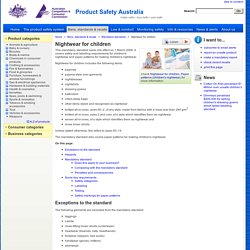
Unless stated otherwise, this refers to sizes 00–14. The mandatory standard also covers paper patterns for making children's nightwear. On this page: Exceptions to the standard The following garments are excluded from the mandatory standard: leggingst-shirtsclose-fitting boxer shorts (underwear)headwear (beanies, hats, headbands)footwear (slippers, bed socks)handwear (gloves, mittens)swimwear. Hazards Death or serious injury Children can suffer severe burns or death if the nightwear clothing they are wearing catches fire. Baby clothes, baby boy clothes, baby girl clothes, newborn baby clothes. Baby shoe sizes Baby shoe sizes is the first thing thought of by a mother before buying baby shoes, without the need to rule out the model, price, brand, and comfort.
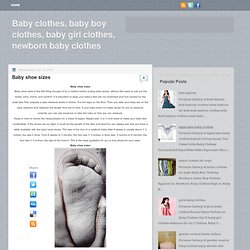
It is important to keep your baby’s feet are not scratched and hurt caused by the small size.First, prepare a tape measure reads in inches. Item.phtml. Country of origin claims and the Australian Consumer Law. The second requirement to make a general country of origin safe harbour defence is that 50 per cent or more of the total cost of production, or manufacture, is attributable to the country claimed to be the country of origin.
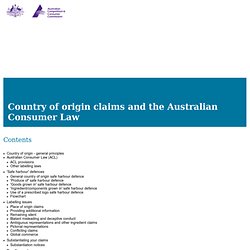
In summary, the cost of producing or manufacturing goods is worked out by adding up the costs of the amounts of expenditure on materials, labour and overheads in respect of the goods. The ACL sets out how these costs are to be calculated.6 Materials. Comlaw. Standards Australia. TFIA - Standards - Labelling. Doing Business In The US Free panel session about exporting to the US, presented by US Commercial Service Australia and Select USA - topics include: export opportunities, finding the right partner, exporter case studies, legal issues, visas/immigration, federal and state incentives | SYDNEY | Tuesday 9 SEPTEMBER, 7am-11:15am Free panel session about exporting to the US, presented by US Commercial Service Australia and Select USA - topics include: export opportunities, finding the right partner, exporter case studies, legal issues, visas/immigration, federal and state incentives | MELBOURNE| Wednesday 10 SEPTEMBER, 9am-12pm Anti-Counterfeiting Strategies for Textile & Fashion Businesses Learn about the wide range of counterfeiting risks in the TCF industry, and how to create a strategy to limit these risks | WEBINAR | Wednesday 17 SEPTEMBER, 12pm-1pm AEST.
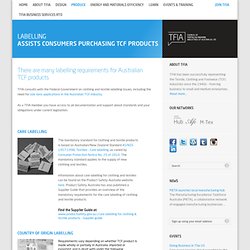
Why women's clothing sizes are all over the shop. National sizing survey needed to reflect changing shape of Australian women.
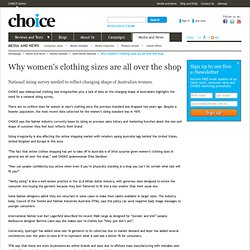
CHOICE says widespread clothing size irregularities plus a lack of data on the changing shape of Australians highlights the need for a national sizing survey. There are no uniform sizes for women or men’s clothing since the previous standard was dropped two years ago. Despite a heavier population, the most recent data collected for the women’s sizing standard was in 1975. CHOICE says the fashion industry currently bases its sizing on previous sales history and marketing hunches about the size and shape of customer they feel best reflects their brand. Sizing irregularity is also affecting the online shopping market with retailers saying Australia lags behind the United States, United Kingdom and Europe in this area. “The fact that online clothes shopping has yet to take off in Australia is of little surprise given women’s clothing sizes in general are all over the shop,” said CHOICE spokeswoman Elise Davidson. CHOICE and clothing size irregularities.
In brief There is no Australian industry standard for adult clothing sizes; as a result, designers and manufacturers are free to make up their own size specifications.
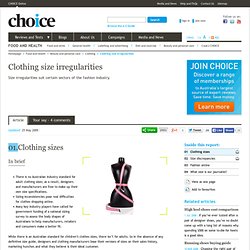
Sizing inconsistencies pose real difficulties for clothes shopping online. Many key industry players have called for government funding of a national sizing survey to assess the body shapes of Australians to help manufacturers, retailers and consumers make a better fit. While there is an Australian standard for children’s clothes sizes, there isn’t for adults. So in the absence of any definitive size guide, designers and clothing manufacturers base their versions of sizes on their sales history, marketing hunches and what they believe is their ideal customer. While this may suit the designers, who can manipulate sizing to give an instant “feel good” factor, as well as deter the “wrong” body shapes from fitting their clothes, consumers are often left having to try on a range of sizes to find the right one. Where to now?
Care labelling for clothing & textiles. The mandatory standard for textiles labelling covers: clothinghousehold textilesfurnishings piece goods made from textilesplastic coated fabricssuede skinsleathersfurs.
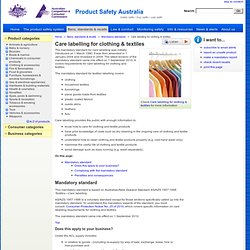
Care labelling provides the public with enough information to: know how to care for clothing and textile products have prior knowledge of costs such as dry cleaning in the ongoing care of clothing and textile products understand how to clean clothing and textile products properly (e.g. cold hand wash only) maximise the useful life of clothing and textile products avoid damage such as dyes running (e.g. wash separately). On this page: This mandatory standard is based on Australian/New Zealand Standard AS/NZS 1957:1998, Textiles—Care labelling. AS/NZS 1957:1998 is a voluntary standard except for those sections specifically called up into the mandatory standard. The mandatory standard came into effect on 1 September 2010.